Minamoto no Yoshitsune: The Tragic Hero Who Shaped Japan’s Samurai Legend
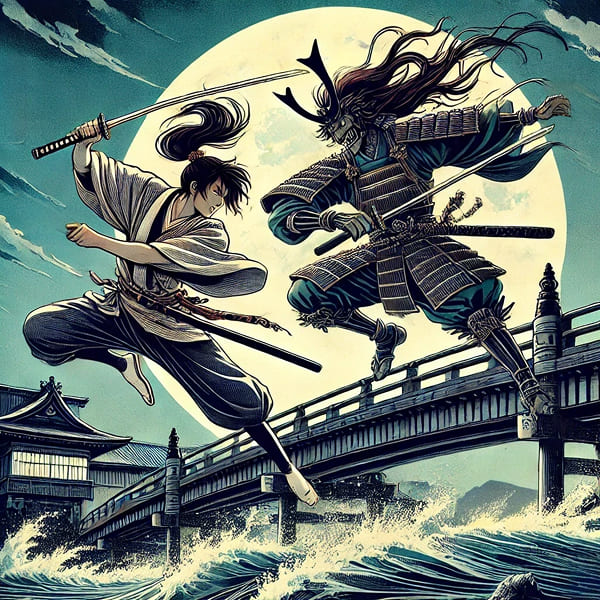
Contents
A fearless swordsman. A devoted brother. A tragic hero.
Have you ever heard of such a man from Japan’s past?
Long ago, there lived a young samurai named Minamoto no Yoshitsune—a warrior celebrated for his brilliance, courage, and a destiny as heartbreaking as it was legendary.
What kind of life did he lead?
How did his name become etched into history?
And what sorrow turned his glory into tragedy?
Come with us on a journey through the life of Yoshitsune—the man whose story still shines through the centuries.
Together, let’s uncover the tale of his courage, loyalty, and the fateful path that made him one of Japan’s most unforgettable heroes.
The Historical Yoshitsune: Warrior and Strategist
Let’s begin by tracing Yoshitsune’s life from a historical point of view.
To truly understand his legend, we need to look at the world that shaped him—an age of turbulence and ambition.
From his birth to his final days, let’s take a brief journey through the story of his extraordinary life.
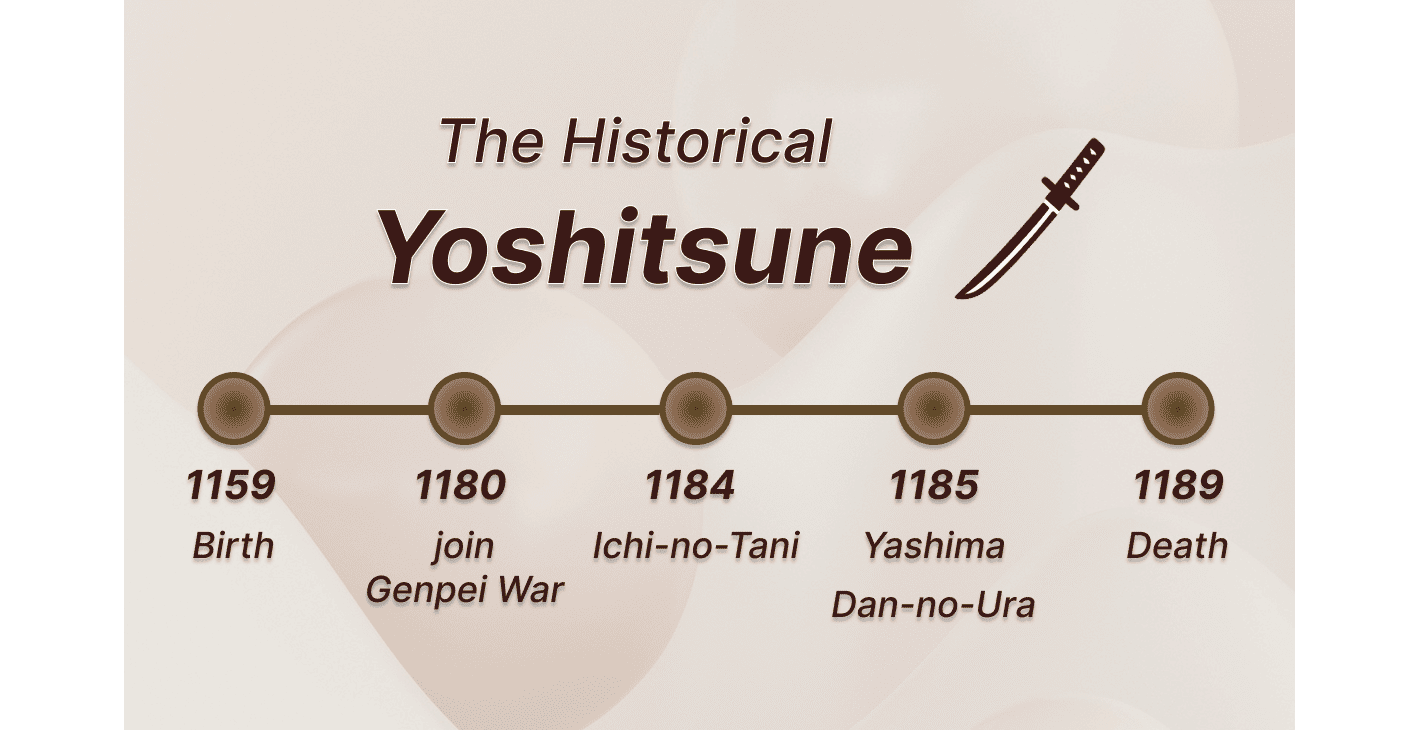
A Childhood Shaped by Conflict
Yoshitsune was born in 1159, during the final years of Japan’s Heian period, as the ninth son of the Minamoto general Yoshitomo.
It was an age of turmoil—when the Minamoto (Genji) and Taira (Heike) clans were locked in fierce battles for power.
Yoshitsune’s father was defeated and killed in the famous Heiji Rebellion, a war that left the Minamoto clan in ruins.
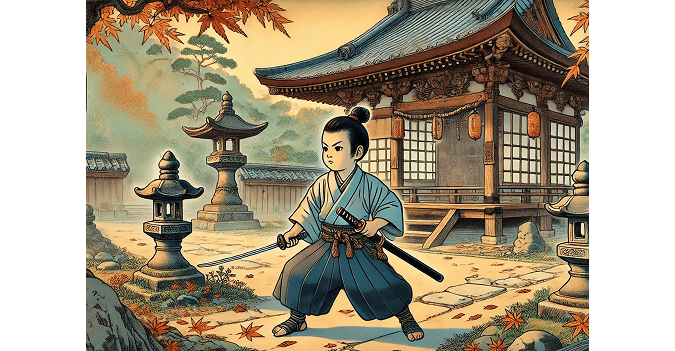
The infant Yoshitsune was spared and sent away to Kurama-dera, a secluded temple deep in the northern mountains of Kyoto.
There, surrounded by towering cedar trees and the distant sound of temple bells echoing through the mist, the boy grew up in silence and solitude.
No one could have imagined that this quiet child, raised far from the world of warriors, would one day shake the very foundations of Japan’s samurai age.
Meeting His Fate: The Warrior Monk Benkei
As Yoshitsune grew into a young man, fate led him to a powerful figure named Benkei—a warrior monk feared throughout Kyoto.
Benkei was known for challenging and defeating countless swordsmen, collecting their blades as trophies from each duel.
One night in Kyoto, their paths crossed in a fierce battle that would mark the beginning of one of Japan’s most legendary partnerships.
Benkei was defeated—not by sheer strength, but by Yoshitsune’s unmatched speed and grace.
Humbled, Benkei knelt before his new master and pledged eternal loyalty.
From that moment on, Yoshitsune and Benkei became inseparable—brothers not by blood, but by honor and faith.
Rising to Glory: The Genpei War
In 1180, Yoshitsune answered the call of his elder brother, Minamoto no Yoritomo, joining the Genpei War—a conflict that would end an era and give birth to the samurai age.
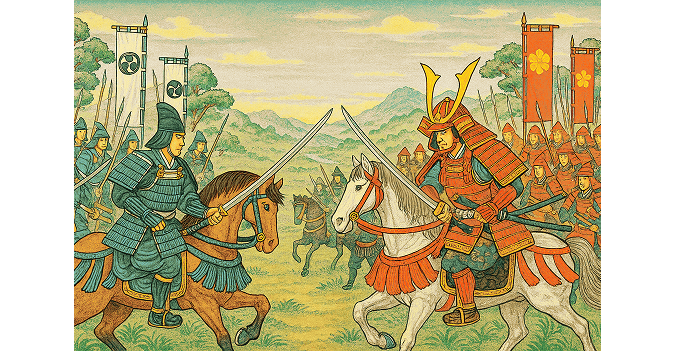
Yoshitsune quickly proved to be no ordinary warrior.
Among his many exploits, several battles stand out as defining moments of his legend.
Ichi-no-Tani (1184)
In a move as daring as it was reckless, Yoshitsune led a handful of horsemen down the sheer cliffs of Hiyodorigoe, surprising the enemy and turning the battle in the Minamoto’s favor.
It was a moment that made him a legend overnight.
Yashima (1185)
Undaunted by stormy seas, he crossed the waves with a small fleet, tricking the Taira by lighting fires across the shore—making his forces appear countless.
The enemy fled in confusion.
Dan-no-Ura (1185)
In the war’s final battle, Yoshitsune seized on betrayal within the Taira ranks and struck at their command ships.
When the tide of war literally turned—dragging the Taira fleet away—their empire was finished.
Through these victories, Yoshitsune played a key role in bringing about the fall of the Taira clan.
A Hero the People Loved
Yoshitsune’s tactics were bold, swift, and strikingly unconventional.
He moved unlike any other commander—quick, unpredictable, and brilliantly inventive.
People admired his grace in battle and his fearless spirit, and soon Yoshitsune became a true hero in the eyes of the people.
Yet, such brilliance did not promise him happiness.
For every gift of genius, there is always a price to pay—and Yoshitsune was no exception.
The Fall: Betrayal and Tragedy
Not everyone celebrated Yoshitsune’s glory.
Among them was none other than his elder brother—Minamoto no Yoritomo, the powerful shogun of the founded Kamakura shogunate.
To Yoritomo, Yoshitsune’s popularity was not a triumph, but a threat to his authority.
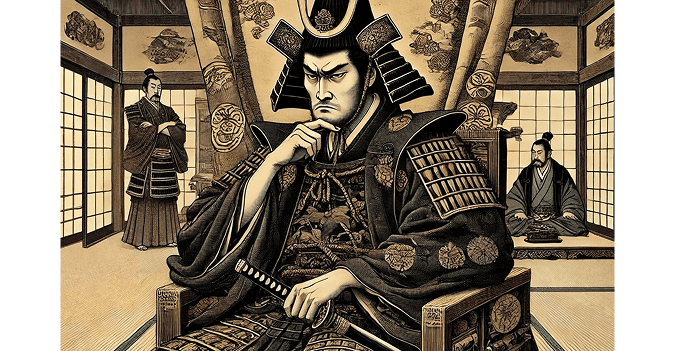
What began as a bond of brotherly loyalty soon turned into fear and jealousy.
Yoritomo branded Yoshitsune a traitor, erasing his victories from the record and forcing him to flee Kyoto in disgrace.
Seeking refuge in the northern lands of Ōshū, Yoshitsune was sheltered by the noble Fujiwara no Hidehira, who offered him protection.
But after Hidehira’s death, his son Yasuhira, under pressure from Yoritomo, turned against the fugitive hero.
In 1189, surrounded and hopelessly outnumbered, Yoshitsune chose death over capture.
It is said that he performed seppuku—the ritual suicide of a samurai—ending his life with dignity and courage.
Through this tragic end, Yoshitsune’s story transformed from history into legend.
Centuries have passed, yet his name still echoes across Japan—a symbol of loyalty, honor, and the sorrow of a hero betrayed.
The Living Legend: Tales Born in Yoshitsune’s Lifetime
How was Yoshitsune’s story so far?
His life may have been short, but his image as a hero captured the imagination of the people—blurring the line between history and legend.
Over time, he became more than just a warrior. He became a symbol of courage, grace, and mystery.
Now, let’s explore some of the legendary tales that made Yoshitsune a timeless icon.
The Mysterious Warrior: Training with the Tengu
One of the earliest legends tells that, as a boy living at Kurama-dera, Yoshitsune was secretly trained by the tengu—mythical, bird-like mountain spirits known for their mastery of martial arts.
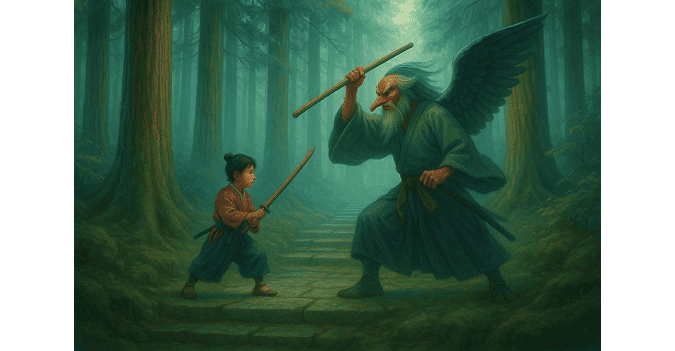
These supernatural teachers were said to have shown him how to fight with elegance and move with lightning speed.
It is said that Yoshitsune’s quick movements and unconventional tactics were deeply influenced by the guidance of the tengu.
A Duel That Forged Loyalty: Benkei at Gojō Bridge
Among all the legends surrounding Yoshitsune, none is more famous than his fateful encounter with Benkei.
Benkei, a fearsome warrior monk, had sworn to collect one thousand swords from defeated samurai.
He had already claimed 999 when he set his sights on his final target—a young man crossing Kyoto’s Gojō Bridge under the pale light of the moon.
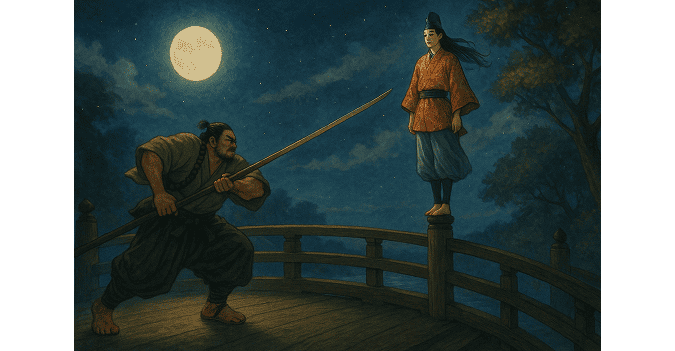
That young man was Yoshitsune.
Calm and composed, he approached while playing a flute, unfazed by the towering monk waiting to strike.
When Benkei attacked, Yoshitsune evaded his blows with graceful precision—his movements said to be guided by the secret training of the tengu.
Defeated and humbled, Benkei knelt before Yoshitsune, vowing lifelong loyalty.
From that night on, the two would be bound together by faith, honor, and destiny—their story echoed in countless retellings for generations to come.
The Eight Boat Leaps: Hassō Tobi
In the final days of the Genpei War, legend tells that Yoshitsune escaped his pursuers at Dan-no-Ura by leaping from ship to ship across the waves.
This astonishing feat came to be known as Hassō Tobi—the “Eight Boat Leaps.”
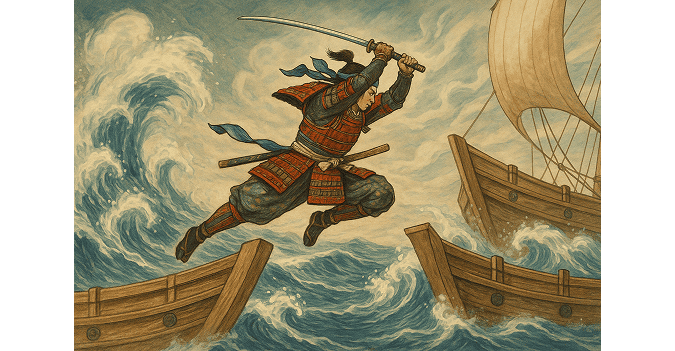
The tale portrays Yoshitsune as a man who transcended human limits—swift as the wind, brave as fire, and free as the sea itself.
He was not merely a warrior, but a force of nature—untamed, unstoppable, and unforgettable.
The Hero Who Never Died: Legends After Death
Interestingly, Yoshitsune’s legend did not end with his tragic death.
In fact, that was only the beginning of new stories that would continue to grow for centuries.
Let’s take a closer look at the legends that emerged after his death— tales that kept Japan’s fallen hero alive in the hearts of the people.
The Vanished Hero
According to several legends, Yoshitsune did not die in the northern lands as history tells.
Instead, he faked his death and escaped even farther north, disappearing beyond the edge of the known world.
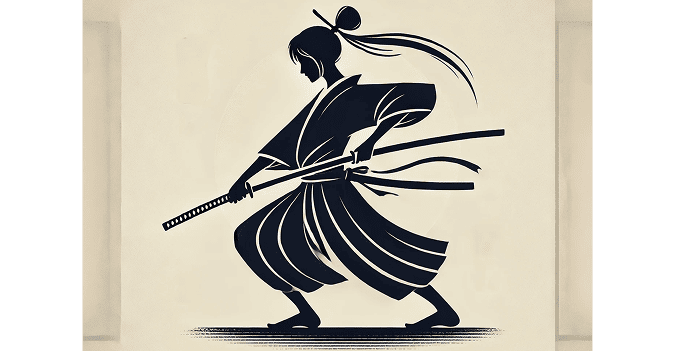
One story claims that he crossed the sea to Ezo—modern-day Hokkaido— where he was welcomed by the indigenous Ainu people and became their great king.
Later generations of Ainu chiefs were even said to be his descendants.
For those who could not accept Yoshitsune’s tragic end, these tales brought comfort and hope.
They transformed him from a fallen warrior into a timeless hero— one untouched by time, power, or death itself.
From Warrior to Conqueror: The Genghis Khan Theory
There is an even more astonishing legend about Yoshitsune— one that reaches far beyond Japan.
According to this tale, Yoshitsune did not die in his homeland.
Instead, he journeyed west, crossing distant lands, and eventually became Genghis Khan, the great conqueror who founded the Mongol Empire.
This legend first appeared in the 18th century and gained wide attention in the early 1900s.
People were fascinated by the idea: perhaps Japan’s tragic hero had returned—not as a victim of betrayal, but as a ruler who reshaped the world itself.
Of course, there is no historical evidence to support this theory.
Yet it reflects something deeply human—a longing to believe that Yoshitsune escaped the cruelty of his age and found a destiny worthy of his greatness.
For those who loved him, his story did not end in sorrow.
It continued to live on, reborn again and again in the hearts of the people— a belief that true heroes never really die.
Why People Chose to Believe
Have you ever wondered why Yoshitsune’s legend has been told in so many forms—and for so many centuries?
The answer lies in the perfect paradox of his story:
victorious, yet betrayed; admired, yet exiled; mortal, yet immortal.
This contradiction captured the hearts of generations, for it revealed a hero both triumphant and tragic—a man both real and mythic.
To the Japanese people, Yoshitsune symbolized far more than bravery or skill.
He embodied the spirit of hangan-biiki (判官贔屓)— a deep cultural sympathy for those who, despite being right or noble, suffer misfortune or injustice.
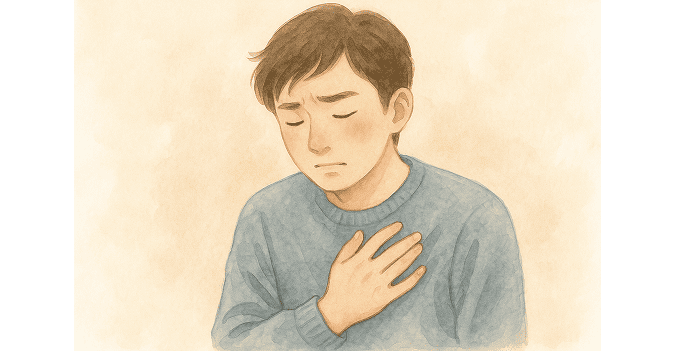
He was the hero who won yet was never recognized;
the man who deserved praise but lost his place in the world;
the warrior who died—or perhaps lived on beyond death itself.
In Yoshitsune, people saw a reflection of their own hopes: a yearning for fairness, a belief that virtue should be rewarded, and a dream that true honor cannot be destroyed by betrayal.
Through his courage, his tragedy, and his unshakable loyalty, Yoshitsune became a mirror of the human spirit—its strength, sorrow, and longing for justice.
His story continues to speak to the heart, not as a tale from the distant past, but as a living memory of courage, grace, and compassion.
And that is why, even now, Yoshitsune remains more than a historical figure— he is a hero who never truly died.
Yoshitsune in Traditional Arts: Noh, Kabuki, and Bunraku
The legend of Minamoto no Yoshitsune has long been a favorite theme in Japan’s traditional performing arts.
From the quiet beauty of Noh to the colorful world of Kabuki and Bunraku, his story has continued to move audiences for generations.
Let’s explore how Yoshitsune’s life and spirit have been brought to the stage through these timeless traditions.
“Kanjinchō” — The Heart of Kabuki
One of the most famous portrayals of Yoshitsune appears in the Kabuki play “Kanjinchō”, first performed in 1840.
Adapted from the older Noh drama Ataka, it tells the story of Yoshitsune and his loyal retainer Benkei, disguised as monks while fleeing from Yoritomo’s soldiers.
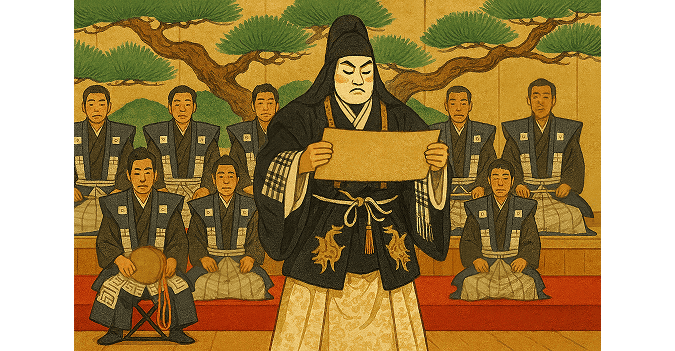
At a checkpoint, Benkei pretends to read a fundraising scroll (kanjinchō).
To protect Yoshitsune’s disguise, he strikes his master in front of the guards—a heartbreaking act of loyalty and courage.
For over a century, Kanjinchō has remained one of the most beloved plays in Kabuki, symbolizing devotion, sacrifice, and honor.
Yoshitsune and Benkei in Noh
Yoshitsune’s story also appears in Noh theater, where slow movement and silence express deep emotion.
- “Funa Benkei” (Benkei on the Boat) shows Yoshitsune and Benkei escaping by sea, haunted by the spirit of Taira no Tomomori.
- “Ataka”, the Noh version that inspired Kanjinchō, tells a tale of disguise, loyalty, and inner strength.
In Noh, Yoshitsune is often shown not just as a warrior, but as a tragic and noble soul, guided by fate and honor.
Bunraku — The Puppet Stage
In Bunraku (traditional Japanese puppet theater), Yoshitsune’s story becomes a poetic epic of loyalty, disguise, and farewell.
The famous play Yoshitsune Senbon Zakura (“Yoshitsune and the Thousand Cherry Trees”) is one of the three great masterpieces of Bunraku, known for its moving portrayal of honor, sacrifice, and hidden identities.
Through elegant puppetry and the soulful sound of the shamisen, the drama unfolds as warriors, nobles, commoners, and even a fox spirit cross paths in a web of fate and devotion.
Yoshitsune Senbon Zakura is not merely a tale of war, but a reflection on love, duty, and the transient beauty of human emotion.
Through these traditional arts, Yoshitsune is remembered not only as a great general, but as a symbol of loyalty, emotion, and human fragility—a hero whose spirit continues to move hearts through Japan’s living traditions.
Yoshitsune in Modern Culture: From Literature to Anime
Even in modern Japan, the allure of Minamoto no Yoshitsune remains as strong as ever.
His legend continues to find new life in popular culture—from novels and manga to anime and television dramas.
Here, we explore the many ways people in Japan still encounter Yoshitsune’s spirit today.

Yoshitsune in Literature
Eiji Yoshikawa reimagined Yoshitsune in Shin Heike Monogatari (New Tale of the Heike), portraying him not as a myth but as a deeply human figure—brave, loyal, yet bound by destiny.
The work emphasized his emotional depth and the quiet dignity beneath his tragic fall.
Yoshitsune in Manga and Anime
The legend of Yoshitsune has reached younger generations through manga and anime, where his story blends history with imagination.
- Tetsuo Hara’s 遮那王義経 (Shanaō Yoshitsune) dramatizes the Genpei War as a tale of fate, courage, and rebirth.
- In educational manga series titled 源義経, he is introduced as both a strategist and a symbol of honor.
- In the 2022 anime The Heike Story, Yoshitsune appears as a key figure opposing the Taira clan—depicted with both power and vulnerability.
Through these adaptations, Yoshitsune remains a figure of admiration—an ideal of justice, resilience, and loyalty.
Yoshitsune on the Small Screen
The NHK Taiga drama Yoshitsune (2005), starring Takizawa Hideaki, offered a nuanced portrayal of his life—his rise to glory, his brother’s betrayal, and his tragic end.
It was the second time Yoshitsune had been chosen as the hero of a Taiga drama, the first being the 1966 series Minamoto no Yoshitsune.
The fact that Yoshitsune has been chosen twice as the central hero of NHK’s Taiga dramas proves just how dramatic and captivating his story is—continuing to inspire Japanese audiences across generations.
His story shows that even in an ever-changing world, the spirit of a true hero—honorable, loyal, and unyielding—never fades.
Yoshitsune’s legend will surely continue to be told, generation after generation.
Pilgrimage and Power: Yoshitsune’s Sacred Sites
Centuries may have passed, but our journey following Minamoto no Yoshitsune’s footsteps is far from over.
Have you found yourself drawn to his legend?
Across Japan, there are still many places said to be connected to Yoshitsune—sites where his spirit and stories live on.
Here are some of the best places where you can still meet Yoshitsune today.
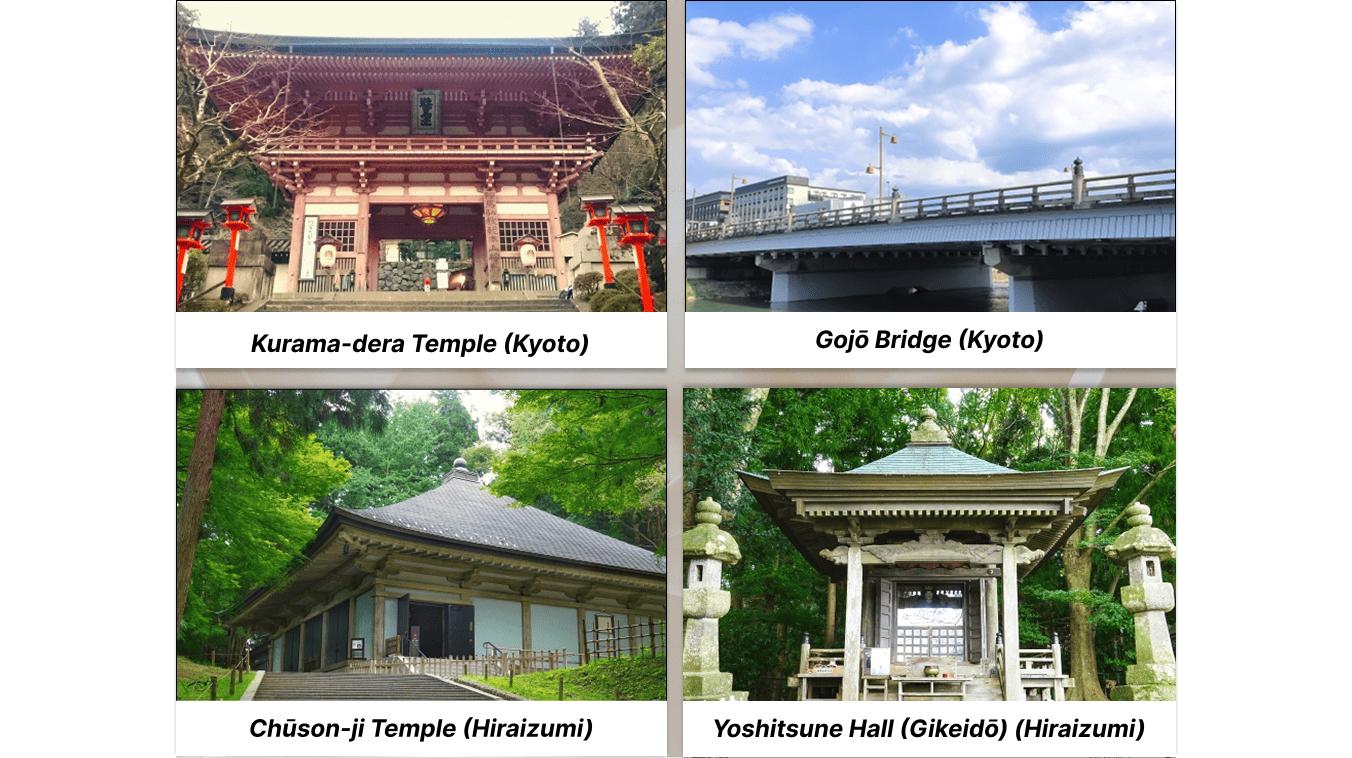
Kurama-dera Temple (Kyoto)
High in the northern mountains of Kyoto stands Kurama-dera, a temple wrapped in legend and mist.
Young Yoshitsune—then known as Ushiwakamaru—trained here under the guidance of monks and learned swift swordsmanship from the long-nosed Tengu spirits.
Even today, the mountain feels sacred and mysterious; each step along its forested paths feels like walking through the pages of a storybook.
- Location: Kurama, Kyoto
- Access:
From Kyoto Station, take the Karasuma Subway Line to Kitaōji Station (about 15 minutes).
Then transfer to a bus bound for Kurama and get off at Kurama Station, the last stop.
Alternatively, from Demachiyanagi Station, you can take the Eizan Railway directly to Kurama Station (about 30 minutes).
From there, it’s a short walk to the temple gate (Nio-mon), followed by a scenic cable car ride (200 yen) up the mountain to the Main Hall (Kondō). - Website (Japanese only): Kurama Temple
Gojō Bridge (Kyoto)
In the heart of Kyoto stands Gojō Bridge, where the mighty warrior monk Benkei once challenged a slender young Yoshitsune to a duel.
Of course, Yoshitsune won—and gained Benkei’s unshakable loyalty in the process.
Today, a bronze statue of the two stands proudly near the bridge, capturing that legendary moment of fate and friendship.
- Location: Near Shijo and Kawabata Streets, Kyoto
- Access:
From Kyoto Station, take the Karasuma Subway Line to Shijō Station, then transfer to the Hankyu Line and get off at Kawaramachi Station.
From there, it’s about a 10-minute walk east toward the Kamo River to reach Gojō Bridge.
Alternatively, you can take the Keihan Line from Kyoto Station (via Tofukuji transfer) to Kiyomizu-Gojō Station—the bridge awaits right outside! - Tourism Info (Japanese): Kyoto Tourism Official Site
Chūson-ji Temple (Hiraizumi, Iwate Prefecture)
Travel north to Hiraizumi, and you’ll find Chūson-ji Temple, where Yoshitsune spent his final days.
A UNESCO World Heritage Site, its famous Konjikidō (Golden Hall) glimmers with peace and sorrow, honoring the fallen hero and his Fujiwara allies who once protected him.
It’s a deeply moving place— quiet, spiritual, and full of history.
- Location: Hiraizumi, Iwate Prefecture
- Access:
From Tokyo Station, take the JR Tōhoku Shinkansen north to Ichinoseki Station (about 2 hours 20 minutes).
Transfer to the JR Tōhoku Main Line local train and ride about 8 minutes to Hiraizumi Station.
Chūson-ji Temple is a pleasant 25-minute walk or a 10-minute taxi ride from the station. - Website (English): Chūson-ji Temple
Yoshitsune Hall (Gikeidō) (Hiraizumi, Iwate Prefecture)
Just a short walk from Chūson-ji stands Yoshitsune Hall (Gikeidō), a small but heartfelt shrine dedicated to Yoshitsune’s spirit.
Locals say this is where he spent his last moments, and even now, visitors leave offerings of gratitude for his courage and loyalty.
It’s a quiet stop that feels like a whispered farewell between history and legend.
- Location: Hiraizumi, Iwate Prefecture
- Access: Same as Chūson-ji
- Website (English): Takadachi Gikeidō
In this way, all across Japan, the traces of Minamoto no Yoshitsune’s journey can still be found today.
From Kyoto’s misty mountains to the tranquil temples of Hiraizumi, each place keeps his legend alive.
If you ever have the chance to travel through Japan, be sure to visit these places yourself—and experience the spirit of one of the nation’s most beloved heroes firsthand.
Conclusion: Why Yoshitsune Still Matters
Even after more than 800 years, Minamoto no Yoshitsune remains one of Japan’s most beloved heroes— not because he won, but because he faced defeat with unshakable honor.
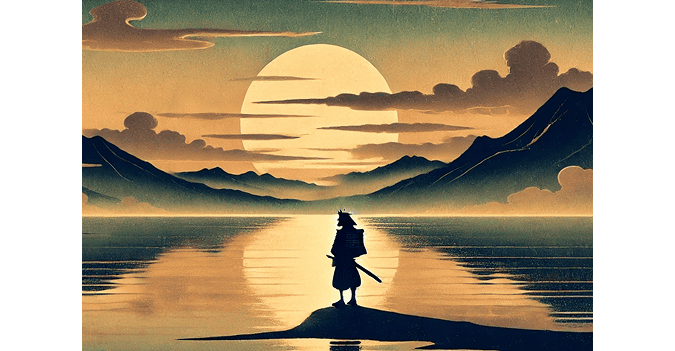
His life was brilliant yet betrayed, victorious yet exiled, admired yet hunted.
And it is precisely because of this that Yoshitsune proves a simple truth: true greatness lies not in power, but in integrity and the strength to stay true to one’s heart.
Through the traditional arts, popular culture, and the sacred sites that still honor his memory, Yoshitsune’s legend continues to live on across generations.
Even today, his story speaks to us— that there is dignity in struggle, beauty in resilience, and that sometimes, the most enduring victories are the ones won within the heart.